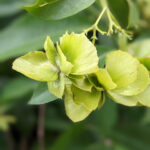Botanical Name/Etymology: Ilex guayusa
Family Name: Aquifoliaceae
Common Name(s): Guayusa (gwhy-you-sa)
Origin: Western South America – particularly Ecuador, northeastern Peru and Southwestern Colombia
Growth Habit: Small shrubby tree
Growth (Cultural) Requirements: Warm tropical conditions with a marked wet and dry season. Guayusa is an understory tree and needs the shade of other trees.
Propagation: Cuttings, because apparently it has been so long in cultivation and has been so highly selected that it no longer produces seeds. It takes three years until a new tree is mature enough (about 8 feet tall) to be harvested.
Folklore and History: Michael Harner, the founder of the Foundation for Shamanic Studies, describes how “the Jivaro say guayusa is so habituating that before it is offered to a visitor, he is warned that once he drinks it, he will ever always after return to the Ecuadorian Jungle.” (Wikipedia)
-The Kichwa people claim that guayusa induces dreams that foretell whether hunting expeditions will be successful.
(Wikipedia)
-A 1,500-year-old bundle of guayusa leaves was found by Harvard University ethnobotanist Richard Evans Schultes in a medicine man’s tomb high in the Bolivian Andes, far beyond the natural range of the plant. (Wikipedia) Chemistry (if known – especially active essential oils): caffeine (about 3% by weight), theobromine, L-theanine (an amino acid which is purported to give a feeling of pleasant tranquility), and glutamic acid (shown to reduce physical and mental stress)
Plant Part(s) Used: Leaves – dried and used for brewing a tea
Time of Harvest: Fresh leaves are harvested at any time.
GRAS? (generally regarded as safe): no, but long used and not likely to be hazardous
Culinary Uses: tea – Runa is probably the most notable brand in the US and is sold locally at HEB.
Medicinal Uses: Guayusa contains all the essential amino acids needed by humans and has an antioxidant value
about twice as high as that of green tea. Guayusa is supposed to give you a sustained level of energy without a noticeable drop in energy as it wears off. Its caffeine level is less than coffee but higher than green tea.
Sources for Seed or Plants: plants: www.botanicalspirit.com
Bibliography:
Van Wyk, Eric 2005 Food Plants of the World Portland: Timber Press
Van Wyk, Eric 2013 Culinary Herbs & Spices of the World Chicago: University of Chicago Press
www.wikipedia.com
www.runa.org
Submitted by Henry Flowers
It is the policy of The Herb Society of America not to advise or recommend herbs for medicinal or health use. This information is intended for educational purposes only and should not be considered as a recommendation or an endorsement of any particular medical or health treatment.









